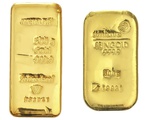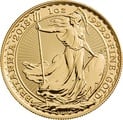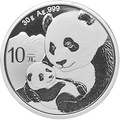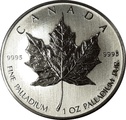Precious metals
There are 8 elements currently designated as precious metals. These are; gold, silver, platinum, palladium, iridium, osmium, rhodium and ruthenium.
A precious metal is typically a rare, metallic element, with a high economic value. Though not synonymous, precious metals are often ‘noble’ metals, meaning that they are less reactive than many other metals. Over long periods of time they won't corrode or rust, helping them to retain their value. All eight of the precious metals remain valuable today, and have a wide array of uses, from industrial and chemical, to art and jeweller, or of course as an investment commodity.
Precious metals are considered some of the best assets for diversifying any investment portfolio. Rare, useful, highly valued and finite in supply, these precious metals can protect your wealth against economic uncertainty – and have the potential to make gains too!
Gold and silver are the two best-known - and most frequently invested - precious metals; their history stretches back thousands of years, being used in coinage, art, and jewellery, but they are not the only precious metals used for investments. At BullionByPost we stock precious metal coins and bars made from gold and silver, but also platinum and palladium.
Designation as a precious metal can also change; aluminium was for many years considered as precious, but is considered relatively common today. Despite being the most abundant metal in the Earth’s crust, aluminium was originally difficult to extract from its naturally occurring forms, and this made it incredibly rare. At one time it was even valued higher than gold! Adoption of modern techniques – such as the Hall-Héroult process – meant that aluminium was much more easily obtained, and its price dropped considerably, stripping it of its precious metal status.
Precious metals list
Lists of precious metals can differ slightly from source to source, but below is a list of the generally accepted precious metals by the scientific community:
- Gold – Famed for its beautiful yellow lustre, gold has been used in jewellery and coinage for millennia. In modern times it also has a number of industrial uses, further helping its demand grow.
- Iridium – Iridium is one of the densest metals, and also has one of the highest melting points of any metal. It has various uses from jewellery to medicine.
- Osmium – With a similarly high density to that of iridium, osmium is very brittle and hard, and as such is used in alloys to improve durability.
- Palladium – A popular alternative to platinum, palladium is mostly mined in Russia, and has seen prices climb above gold recently due to high demand in the automotive industry.
- Platinum – Platinum has seen impressive growth in price in the past decade, and was once more expensive than gold. The adoption of palladium in the automotive industry however, has seen platinum fall in value in recent years.
- Rhodium – One of the ‘platinum group metals’ or PGMs, rhodium is highly reflective, and is used to make jewellery and mirrors shiny.
- Ruthenium – Another PMG, ruthenium is traditionally used in alloys to improve durability and resistance to corrosion, similar to osmium.
- Silver – As with gold, silver has been mined and coveted as a precious metal for thousands of years, and is incredibly useful.
Most precious metal in the world?
Thanks to the changing nature of precious metals, it is difficult to say which is the most precious metal in the world. Gold would certainly spring to mind for many people but, in terms of value/weight, gold is not the most expensive. As can be seen in the section below, palladium is arguably the most precious metal at the moment, but this could change over the course of time.
The most precious metal in the world is in theory that which is most in demand, with the least supply. This should mean it is the most expensive or precious. This will fluctuate as new supplies are discovered or demand changes. Platinum is a good example of this, and was considered the most precious metal a few years ago. Even today, a platinum award or medal is considered to be above gold, even though it is actually lower in value today.
Precious metal prices
Customers can view live precious metal prices for gold, silver, platinum and palladium using our live charts. These can be customised for time, weight and currency as required. Gold and silver regularly garner attention in the bullion market, but platinum and palladium can also command impressive prices.
Precious metal prices are set by various groups around the world, including the London Bullion Market Association here in the UK. This is typically an agreed spot price for the metal in question, and will usually be quoted in troy ounces, or grams.
As a physical commodity precious metal prices are ultimately driven by supply and demand, but it can take time for this to be reflected. Prices will mostly move throughout the day in reaction to economic news. Shows like the global pandemic, stock market crashes, interest rates or war, can all see precious metal prices rise or fall according to market interpretation of the news.
Whichever precious metal you choose, the fact that finite amounts exist means their value is protected versus paper money. While money can be printed on the whim of governments and central banks, there will only ever be a set supply of precious metals, making them the ideal way to diversify your portfolio, and reduce the risk of economic uncertainty.
- How To Buy Gold
- How to Buy?
- Payment Options
- Delivery Options
- Gold Storage
- Storage at Brink's
- Gold Investment Guide
- Why buy gold?
- Is gold a good investment?
- Why physical gold?
- Best time to buy gold?
- Gold bars vs coins?
- Gold vs Silver
- Gold - Silver Ratio explained
- VAT on bullion
- CGT on bullion
- Legal tender coins
- Top 5 Gold Investments
- Top 5 Silver Investments
- Gold vs ISAs
- Gold vs Buy-to-Let
- Gold vs FTSE 100
- Gold vs Bitcoin
- Where to buy gold?
- Why buy from us?
- Where to sell gold?
- Coin Shops
- Gold Price Forecasts
- Top 10 Gold Producers
- Top 10 Gold Reserves
- Gold Britannia vs Sovereign
- Britannia coin designs
- Sovereign coin designs
- Sovereign Mintages
- Sovereign mint marks
- British coin specs
- What is a proof coin?
- Royal Mint bullion
- The Queen's Beasts
- Royal Mint Lunar Coins
- Bullion Refiners
- British coin mints
- Krugerrands
- Gold Tola - India & Pakistan
- Bullion Index












